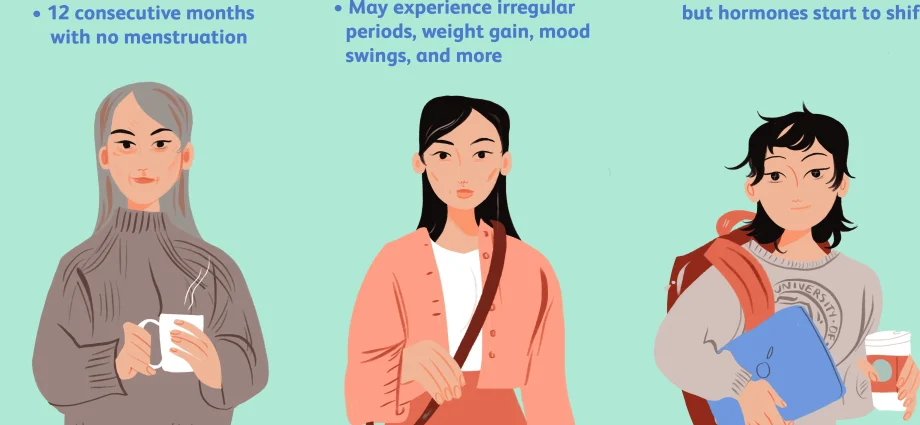Contents
Many consider the cessation of menstruation to be the beginning of menopause – and they are mistaken. Menopause begins long before the end of the menstrual cycle. This period consists of several stages, during which a woman gradually loses the ability to conceive due to changes in hormonal levels. Changes are reflected in the nature of menstruation – their duration and regularity change.
Our experts told how menstruation goes during menopause, how long this period lasts, whether pregnancy can occur, and whether it is possible to maintain and restore a normal menstrual cycle.
What is climax?
The word “climax” is consonant with the Greek Climacter, which means “ladder”. This very accurately characterizes the changes that occur in the female body in stages, literally “step by step”. During menopause, the function of the ovaries decreases, and then completely “turns off”1. They reduce the so-called ovarian reserve, that is, the number of follicles – future eggs1. Because of this, the ability to conceive is significantly reduced. The ovaries begin to produce less and less of the female sex hormones that control the menstrual cycle. Periods become irregular and then stop completely.
According to the criteria of reproductive aging adopted in 2011, several periods of menopause are distinguished.2:
- Menopausal transition, during which the level of sex hormones and the length of the menstrual cycle changes. This period begins at about 40–45 years of age.3.
- Perimenopause – the period that includes the menopausal transition plus 12 months after the last menstrual period3.
- Menopause is the permanent cessation of menstruation. Menopause occurs when a woman has not had a period for 12 months. Menopause can be premature (before 40 years), early (40-45 years), timely (46-54 years) and late (over 55 years)3.
- Postmenopause – the period after the cessation of menstruation and until the end of a woman’s life3.
The average age of menopause in women in our country is 51 years. In all representatives of the weaker sex, hormonal changes during menopause occur according to the same pattern. At the same time, the duration of each stage and the signs of hormonal changes in different women can be very different. The nature of menstruation with menopause will also be different.
How do menstruation go before menopause in women
Before menopause, a woman retains her usual menstrual cycle. Normally, its duration is from 21 to 35 days, the average is 28 days. The normal duration of menstruation varies from 3 to 7 days. Average values may vary slightly in both directions.
Changes in a stable cycle can indicate pregnancy (including ectopic), diseases of the reproductive system, endocrine disorders. If the cycle has become too long or short, the discharge is more scarce or plentiful, the most reasonable solution would be to consult a doctor. Perhaps the specialist will determine that these signs indicate the onset of the menopausal transition.
How do menstruation go with menopause in women
During the menopausal transition – one of the stages of menopause – the menstrual cycle begins to change. Changes are individual and largely depend on heredity, lifestyle, and the state of health of a woman.
As a rule, at the beginning of menopause, menstruation becomes more abundant, and the duration of the cycle is reduced. Then the interval between periods begins to increase. They can come once every 1-2 months, then even less often, and finally stop. If menstruation is absent for a year or more, then the woman has menopause.
How do menstruation go after menopause in women
Menopause ends with postmenopause. During this period, menstruation completely stops. There is only one way to restore the cycle – by taking drugs that make up for the deficiency of female sex hormones.
The drugs are prescribed for women who have menopause before the age of 40 (premature) or before 44 years (early), as well as for patients who want to maintain regular menstruation and eliminate the symptoms of menopause: hot flashes, excessive sweating, irritability, and more serious disorders of the heart vascular, nervous and musculoskeletal systems4.
Popular questions and answers
Features of the menstrual cycle during menopause raise many questions in women. Our experts answer the most popular of them:MD, gynecologist, Olga Antropova, gynecologist of the highest category Elvira Semenova и obstetrician-gynecologist Shkolnikova Anna.
How long can menstruation go with menopause?
Is it possible to restore a normal cycle with menopause in women?
Hormonal medications can help maintain regular periods during perimenopause and restore the cycle during menopause. But do not take them as a “youth pill.” They are not able to stop the fading of ovarian function. Taking drugs is needed to improve the quality of life of a woman, and to prevent diseases that may develop due to a decrease in the level of sex hormones.
How to distinguish menstruation with menopause from bleeding?
The following symptoms should be alert:
• too abundant (more than 80 ml per day) or too poor “spotting” discharge;
• prolonged menstruation – more than 8 days;
• selection of too bright scarlet color;
• too short cycle – less than 21 days;
• spotting after intercourse.
Bleeding in menopause occurs with spontaneous abortion, against the background of hormonal disorders and diseases such as endometriosis, uterine fibroids, malignant tumors of the reproductive organs. Abnormal bleeding may be accompanied by a decrease in blood pressure, pain in the lower abdomen. The doctor should determine the exact cause of the bleeding.
Is it possible to get pregnant during menopause?
Sources:
- Menopause and menopause in women. Clinical guidelines 2021. Russian Association of Obstetricians and Gynecologists. https://clck.ru/drJwC
- Menopausal Hormone Therapy: What Should a Physician Know? Journal “Attending Doctor” dated 13.03.2017/2017/03. I. V. Madyanov, T. S. Madyanova https://www.lvrach.ru/15436678/XNUMX/XNUMX
- Letter from the Ministry of Health of the Russian Federation http://rpc.karelia.ru/docs/FilePath_408.pdf
- Menopausal disorders: effective ways of correction. Methodical manual for doctors. O. V. Yakushevskaya. Moscow 2017 https://disk.yandex.ru/i/DC4kKygrpSl24w











კითხვამაქვს შეგიძლიათ პასუხი გამცეთ